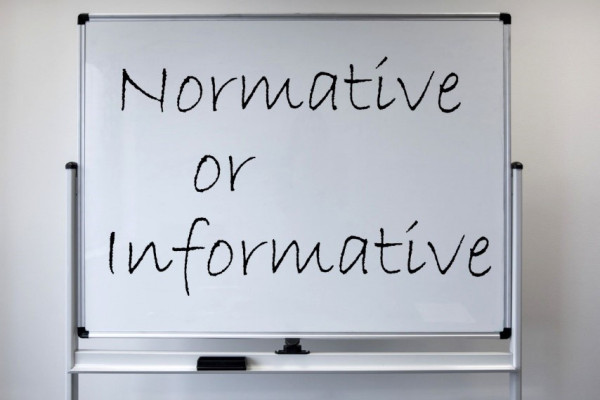Normative vs informative
Standards may sometimes be referred to as containing either normative or informative information, but what does this actually mean?

Understanding the terminology used in standards can help you as a user. Whether that’s integrating them into policy or applying them within the field – to know whether you’re being told you are required to do something or whether it is simply optional practice to do something a particular way.
Normative elements are those that are prescriptive. These show you how to comply with the standard or, if the standard is referenced in legislation, how to follow the law.
Informative elements are those that provide useful or interesting information or are descriptive and offer help to understand concepts. They can also include recommendations, suggested good practice that a reader need not follow to conform to the standard.
Normative
Standards will often use words like:
- Shall – indicates a requirement to be followed for conformity.
- Should – indicates a recommendation which the user is encouraged to follow.
- May – indicates a permission or option to follow as described.
It is the first of these words, ‘shall’, that is the cornerstone of normative content.
Why ‘shall’?
If something is a requirement of the standard why isn’t the word ‘must’ used? This goes to the heart of what a standard is. While legislation obliges you to do or not do certain actions, the standard itself is not actual legislation. Strictly speaking standards are voluntary guidelines. Some are used as a tool to comply with legislation, but they are written with more of a focus on good practice.
‘You must not pass’, means it is against the law to pass, such as over double yellow lines. ‘You shall not pass’ means that in order to comply with this requirement you cannot choose to pass. There is a hidden ‘to comply’ behind every shall. ‘[To comply] you shall do X.’ You are voluntarily choosing to be compliant, hence shall rather than must.

photo credit: You shall not pass by Udri is licensed under CC BY-NC-SA 2.0.
Examples of normative content include product conformity and batch testing requirements for bicycle helmets in AS/NZS 2063:2020 Helmets for use on bicycles and wheeled recreational devices and the safety requirements of remote controls for electric toys in AS/NZS 62115:2018 Electric toys – Safety. Here, when an item is designed specifically for safety or where safe use is paramount, optional content could leave ambiguity that would undermine the standard.
Nearly every standard contains normative information. This is the purpose of standards, to spell out good practice in such a way that is clear what is required to follow it.
Informative
Typically, informative information may be supplemental, offering additional guidance, recommendations, or commentary either as written descriptions or illustrations. The word ‘should’ may be used in informative material, but not ‘shall’ – this is not material a user is required to follow to comply with the standard. It is there to complete the picture and help make sense of the normative requirements.
It is important to remember that the distinction between normative and informative does not mean the actions that are or aren’t mandatory by law. A good example can be seen in the recent publicly available specifications on electric vehicles. SNZ PAS 6011:2021 is designed to provide consumers with guidance on how to safely and cost effectively charge an EV in the home. Nothing in it is a legal requirement and there is no intention (that we know) to make the practice become law.
Nevertheless the specification contains normative content. In order to follow the good practice outlined you ‘shall’ follow the listed requirements. There is also plenty of informative content regarding EV charging apparatus and considerations for consumers. The practice and the information is beneficial (hence why it has been created) but, outside of any regulatory requirements, users are not mandated to follow the guidance.
Telling you what to do with standards
So while both types of content are ultimately used to offer good practice advice and guidance (that’s what standards are for) you now know whether you are being told to do something, advised to do something a particular way or helpfully informed of some of the background. Semantics – or the specific meaning of words – matters when safety, reliability, interoperability and efficiency are at stake. Normative content strives for clarity, spelling out what to do. Informative content helps you see the bigger picture.
